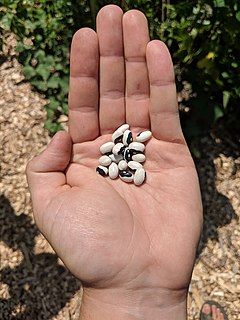
A bean is the seed of one of several genera of the flowering plant family Fabaceae, which are used as vegetables for human or animal food. They can be cooked in many different ways, including boiling, frying, and baking, and are used in many traditional dishes throughout the world.

Sprouting is the natural process by which seeds or spores germinate and put out shoots, and already established plants produce new leaves or buds or other newly developing parts experience further growth.
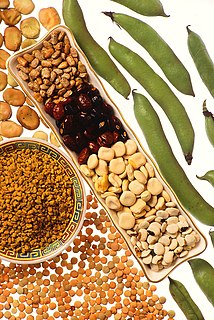
A legume is a plant in the family Fabaceae, or the fruit or seed of such a plant. When used as a dry grain, the seed is also called a pulse. Legumes are grown agriculturally, primarily for human consumption, for livestock forage and silage, and as soil-enhancing green manure. Well-known legumes include beans, soybeans, peas, chickpeas, peanuts, lentils, lupins, mesquite, carob, tamarind, alfalfa, and clover. Legumes produce a botanically unique type of fruit – a simple dry fruit that develops from a simple carpel and usually dehisces on two sides.

Dioscorea alata, also known as purple yam, ube, or greater yam, among many other names, is a species of yam. The tubers are usually a vivid violet-purple to bright lavender in color, but some range in color from cream to plain white. It is sometimes confused with taro and the Okinawa sweet potato, although D. alata is also grown in Okinawa where it is known as beniimo (紅芋). With its origins in the Asian tropics, D. alata has been known to humans since ancient times.

The cowpea is an annual herbaceous legume from the genus Vigna. Due to its tolerance for sandy soil and low rainfall, it is an important crop in the semiarid regions across Africa and Asia. It requires very few inputs, as the plant's root nodules are able to fix atmospheric nitrogen, making it a valuable crop for resource-poor farmers and well-suited to intercropping with other crops. The whole plant is used as forage for animals, with its use as cattle feed likely responsible for its name.

Lima bean also commonly known as the butter bean, sieva bean, double bean, Madagascar bean, chad bean, or wax bean is a legume grown for its edible seeds or beans.

Vigna subterranea is a member of the family Fabaceae. The plant originated in West Africa. Vigna subterranea ripens its pods underground, much like the peanut. They can be eaten fresh or boiled after drying, and can be ground either fresh or dry to make puddings.
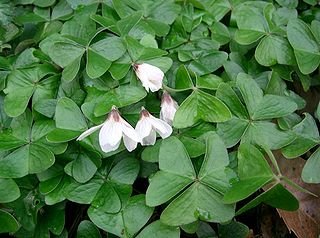
Oxalis is a large genus of flowering plants in the wood-sorrel family Oxalidaceae, comprising over 550 species. The genus occurs throughout most of the world, except for the polar areas; species diversity is particularly rich in tropical Brazil, Mexico and South Africa.

Vegetarian nutrition is the set of health-related challenges and advantages of vegetarian diets.

Coumarin or 2H-chromen-2-one is an aromatic organic chemical compound with formula C9H6O2. Its molecule can be described as a benzene molecule with two adjacent hydrogen atoms replaced by a lactone-like chain −(CH)=(CH)−(C=O)−O−, forming a second six-membered heterocycle that shares two carbons with the benzene ring. It can be placed in the benzopyrone chemical class and considered as a lactone.

Chlorogenic acid (CGA) is the ester of caffeic acid and (−)-quinic acid, functioning as an intermediate in lignin biosynthesis. The term "chlorogenic acids" refers to a related polyphenol family of esters, including hydroxycinnamic acids with quinic acid.

Ferulic acid is a hydroxycinnamic acid, an organic compound. It is an abundant phenolic phytochemical found in plant cell walls, covalently bonded as side chains to molecules such as arabinoxylans. As a component of lignin, ferulic acid is a precursor in the manufacture of other aromatic compounds. The name is derived from the genus Ferula, referring to the giant fennel.
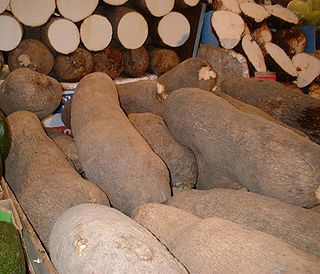
Yam is the common name for some plant species in the genus Dioscorea that form edible tubers. Yams are perennial herbaceous vines cultivated for the consumption of their starchy tubers in many temperate and tropical regions, especially in West Africa, South America and the Caribbean, Asia, and Oceania. The tubers themselves, also called "yams", come in a variety of forms owing to numerous cultivars and related species.

Kaempferol (3,4′,5,7-tetrahydroxyflavone) is a natural flavonol, a type of flavonoid, found in a variety of plants and plant-derived foods including kale, beans, tea, spinach, and broccoli. Kaempferol is a yellow crystalline solid with a melting point of 276–278 °C (529–532 °F). It is slightly soluble in water and highly soluble in hot ethanol, ethers, and DMSO. Kaempferol is named for 17th-century German naturalist Engelbert Kaempfer.

Tylosema esculentum, with common names gemsbok bean and marama bean, is a long-lived perennial legume native to arid areas of southern Africa. Stems grow at least 3 metres, in a prostrate or trailing form, with forked tendrils that facilitate climbing. A raceme up to 25 millimetres (1 in) long, containing many yellow-orange flowers, ultimately produces an ovate to circular pod, with large brownish-black seeds.

Burkinabé cuisine, the cuisine of Burkina Faso, is similar to the cuisines in many parts of West Africa, and is based on staple foods of sorghum, millet, rice, fonio, maize, peanuts, potatoes, beans, yams and okra. Rice, maize and millet are the most commonly eaten grains. Grilled meat is common, particularly mutton, goat, beef and fish.

Antinutrients are natural or synthetic compounds that interfere with the absorption of nutrients. Nutrition studies focus on antinutrients commonly found in food sources and beverages. Antinutrients may take the form of drugs, chemicals that naturally occur in food sources, proteins, or overconsumption of nutrients themselves. Antinutrients may act by binding to vitamins and minerals, preventing their uptake, or inhibiting enzymes.
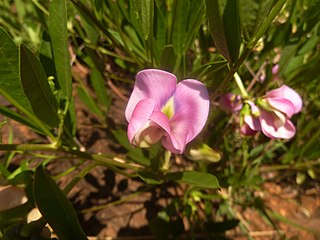
Sphenostylis is a genus of flowering plants in the legume family, Fabaceae. It belongs to the subfamily Faboideae. Sphenostylis contains several species useful as food sources including Sphenostylis stenocarpa.
Scutellonema bradys, also known as yam nematode, is a migratory endoparasitic nematode causing major damage to yam crop in many African tropical regions, as well in parts of South and Central America and Asia. They can cause reduction of 20-30% in tuber weight at harvest.

















